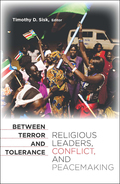Ilankai Tamil Sangam30th Year on the Web Association of Tamils of Sri Lanka in the USA |
|||
 Home Home Archives Archives |
The Spoiler and the ReconcilerBuddhism and the Peace Process in Sri LankaBook chapter by Susan Hayward, December 2011
Book blurb: Civil war and conflict within countries is the most prevalent threat to peace and security in the opening decades of the twenty-first century. A pivotal factor in the escalation of tensions to open conflict is the role of elites in exacerbating tensions along identity lines by giving the ideological justification, moral reasoning, and call to violence. "Between Terror and Tolerance" examines the varied roles of religious leaders in societies deeply divided by ethnic, racial, or religious conflict. The chapters in this book explore cases when religious leaders have justified or catalyzed violence along identity lines, and other instances when religious elites have played a critical role in easing tensions or even laying the foundation for peace and reconciliation. This volume features thematic chapters on the linkages between religion, nationalism, and intolerance, transnational intra-faith conflict in the Shi'a-Sunni divide, and country case studies of societal divisions or conflicts in Egypt, Israel and Palestine, Kashmir, Lebanon, Nigeria, Northern Ireland, Sri Lanka, Sudan, and Tajikistan. The concluding chapter explores the findings and their implications for policies and programs of international non-governmental organizations that seek to encourage and enhance the capacity of religious leaders to play a constructive role in conflict resolution.
The Spoiler: I have occasionally lamented with Sri Lankan Buddhist monks about the manner in which the Sri Lankan sangha (the monastic community) has become a global exemplar. When evidence is presented that no religion is immune to becoming a vehicle for violence, Sri Lanka's orange-robed monks are pointed to as an example of a militant form of Buddhism. |
||
|
|||
 Chapter in "Between Terror and Tolerance: Religious Leaders, Conflict, and Peacemaking," edited by Timoty D. Sisk, Georgetown University Press, December 2011
Chapter in "Between Terror and Tolerance: Religious Leaders, Conflict, and Peacemaking," edited by Timoty D. Sisk, Georgetown University Press, December 2011  From Introduction, p. 4: The book's principal conceptual orientation is laid out by David Little in chapter 1, in which he analyzes the critical question of the complex relationship between relition, ethnonationalism, and intolerance. What religion can provide at times in divided societies is the "hateful motive" for intolerance that can lead to mass violence -- at the extreme end, indiscriminate acts such as terrorism and genocide. While religion is instrumental and manipulable in the application of most leading faith traditions toward or away from conflict, it cannot be a "cause" of conflict as such. Religious belief, however, constructively shapes the terms of conflict and provides an ideational framework through which conflict can be interpreted. While root causes of conflict are often found in injustice, indignity, marginalization, inequality, deficits of basic needs, or the greed of a few, the state can be captured to be complicit in such mass violence. In Little's vision, the critical question is the degree and nature to which religious identity blurs with ethnic identity and is fused with the conceptualizations of the "nation" and the state.
From Introduction, p. 4: The book's principal conceptual orientation is laid out by David Little in chapter 1, in which he analyzes the critical question of the complex relationship between relition, ethnonationalism, and intolerance. What religion can provide at times in divided societies is the "hateful motive" for intolerance that can lead to mass violence -- at the extreme end, indiscriminate acts such as terrorism and genocide. While religion is instrumental and manipulable in the application of most leading faith traditions toward or away from conflict, it cannot be a "cause" of conflict as such. Religious belief, however, constructively shapes the terms of conflict and provides an ideational framework through which conflict can be interpreted. While root causes of conflict are often found in injustice, indignity, marginalization, inequality, deficits of basic needs, or the greed of a few, the state can be captured to be complicit in such mass violence. In Little's vision, the critical question is the degree and nature to which religious identity blurs with ethnic identity and is fused with the conceptualizations of the "nation" and the state.